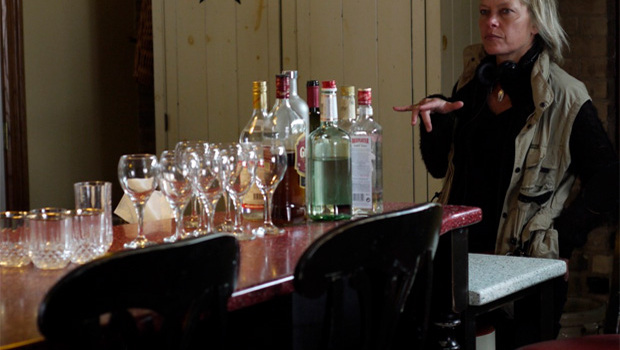The Biz Interview: Penelope Buitenhuis – Director of “A Wake”
Penelope Buitenhuis is an award-winning Canadian director and former UBC film student, who began as an internationally-acclaimed short film director (Guns, Girls, and Guerillas, but has since expanded her reach into an equally successful career in feature films (Trouble, Dangerous Attraction, Tokyo Girls) and television (Train 48).
Her newest film, A Wake, opens in Vancouver theatres on April 29th. The film focuses on the aftermath of a theatre director’s death and specifically the actors and secrets that he has left behind. Penelope was kind enough to share an insider’s perspective on the development of the film, the challenges of creating an improv-heavy story, and her own entertainment inspirations.
Can you walk us through the creative process of A Wake from casting all the way to post-production?
A Wake is a movie about actors, played by actors and I wanted the characters to feel very real and visceral, which improvisation brings out. Without memorization, actors are in the moment, not sure what’s coming next giving the film a raw, unpredictable quality. The richer and multi-dimensional the characters, the more an audience are invested in them. As we don’t have big budgets in Canada for visual effects, good acting and story telling is vital. The film is a mystery so the challenge was to find actors that would not give up their cards too easily, feeling tension and emotion without words.
The Raj character was written for Raoul Bhaneja, our Hamlet expert, as was Maya for Krista Sutton (the co-writer) and Paul Braunstein for the neighbour. I had directed them in many episodes of Train 48, an improv show on Global that went to air the same day we shot. I knew they could handle it. We needed a charismatic director that audiences would believe could wield so much power over his troupe and Nicholas Campbell was the perfect eccentric.
The auditioning process was difficult, as many actors don’t feel comfortable without a script. The actors were given three scenes from the treatment (a 30 page document with 90 scenes containing brief descriptions) and told to prepare a Gabor monologue. Paul Braunstein, Raoul Bhaneja and a female reader took turns improvising with the actors.
Casting is very instinctual for me. I know when an actor feels believable and right for the part. Although Tara Nicodemo, who plays Hanna, had only done theatre, she was a natural and had that French mysterious air I was looking for. It was difficult finding Danielle as she needed to be wild and sexual and many young actors didn’t feel authentic. When Sarain Boylan walked in and gave it her all, I knew she was the real thing and she proved the best provocateur. Martha Burns shows incredible restraint in the film, again not too talkative but when she does you feel it.
Before shooting we rehearsed for 3 days, mostly the big scenes where 7 actors are vying for space. We then needed to find a large country house that could house all the departments (as we had no money for trucks) and have enough room for two cameras shooting in opposing directions. We finally found it in Cambridge, Ontario and the family was wonderful and helpful (digging out cars from the snow etc.). My DOP Francois Dagenais and I wanted a European sensibility for lighting – dark, real and very sourcy so he pre-lit the house, hiding lights and hanging them where they could to allow us the freedom to shoot in all directions. The house needed to feel like a worldly renowned theatre director lived there, so my production designer Peter Cosco moved my entire art collection from my house to location, adding heavy theatrical curtains so we could shoot night for day interiors. We shot in ten days and because each take is a scene with no turning around (except for the 2 big scenes) we could do many takes, changing lens sizes and shoot incredibly fast. Except for dealing with large amounts of snow (which looks beautiful on screen), the whole shoot went smoothly and with a very small crew, we were efficient, only leaving the house area for lunch at the nearby church. With no location moves we hunkered down and shot a lot with the actors rarely waiting. Our sound recordist Sylvain Arsenault was amazing at mixing lavs and boom so there is almost no ADR in the film.
James Bredin and I spent 4 months editing, constantly mining for golden moments of improvisation. Because we kept the blocking the same in each scene, we could cut between takes and had a wealth of material. To maintain the mystery and tension in A Wake, we had to carefully eek out clues about the theatre troupe’s past, never revealing too much, for it is the “unsaid” that is intriguing. A good film keeps us on our toes so we were careful with A Wake to keep the audience guessing and leave them putting the pieces together even after the film is over. There is very little music in the film and mostly source, as I don’t like manipulative score telling us how to feel. The acting should not require music to work. I also wanted to use Canadian songs so we have a mix of Latin sounding Lhasa, indie rock Danny Michel and Luc Ducet with some classical tunes. Aaron Davies composed a sparse score for short interludes where needed. The sound design is simple and real, following in the dogma tradition without the rules. The aim: to get at the truth for it will set you free.
With A Wake, you challenged your actors with a story structure that encouraged improvisation rather than staying close to a completed script. Did you have a clear vision of what you wanted or did you need to remain consistently open to the improvisation of your actors through the entire filming process?
In improv, you need to stay open otherwise it squashes the creative spirit. The gems that arise in spontaneous exchange, both comic and tragic, are always surprising, yet one has to be careful not to be seduced by the acting to stay on track with the story. I consider myself an actor’s director. Developing a trusting relationship is paramount. If actors trust my judgment, they will go all the way. I had a very strong sense of how this story needed to go and it was written, so the actors had clear directions of scene content. To follow guidelines but still feel free to create was challenging for the actors. I usually have a bad memory but as continuity couldn’t write the dialogue down, I had to remember every line so actors wouldn’t repeat themselves later. I shocked myself and remembered every word. When in need one can use more than 10% of the brain.
A Wake was co-written by Krista Sutton. Can you describe your writing process?
Krista and I spent almost three years, intermittently, working on the treatment after Train 48 finished. We would brainstorm together and take notes and then I would write it into scenes. We knew the story had to take place in one location so we could shoot chronologically. As my father had just died, we felt a wake would have high stakes and people tend to get truthful when confronted by their own mortality. “Truth” is a theme we wanted to explore and transformation, as I believe audiences like to watch people change in an hour and a half, because in real life, it ain’t so easy. Krista had great stories about working with an intense German theatre director that she adored, so we decided actors’ reuniting for a wake was our story. Then we mapped out our characters and their back-story together, trying to make each very distinct and have lots of secrets. When it started to feel like a French farce as they moved around the house, we pulled scenes and simplified to concentrate on a fewer storylines. It was a puzzle figuring out when each secret would be revealed and to whom and how much. After the first draft we decided Hamlet was the troupe’s last ill-fated production as we already had a son returning to find his father dead and suspecting his – in this case- stepmother. The Hamlet subtext just evolved naturally from there, with Raoul Bhaneja advising us on Shakespeare lines, inserting them sparsely as to not overstate the obvious. We also wanted to make it a dark comedy, so not to get too earnest. When you write without dialogue, it forces you to get at what a scene is about which I love.
You have directed television projects (Train 48) as well as film. From a directing point of view, what do you enjoy about each?
A film is a long process of writing and raising money and eventually you get to realize your baby, if you are lucky. After so much time investment, there is a lot of pressure to make it happen and yet so many aspects are out of your control (distribution/funding actors etc). So I love film cause I can instill my vision from beginning to end, but I love television cause you come in after all that has been done. You prep and shoot and spend a short time editing. It is fast and many of the decisions have already been made (casting/ shooting style etc) so I can concentrate on the performances and story telling.
Who are the Canadian actors and directors who have inspired you along the way through your career?
Director Daryl Duke was my mentor for years and his honesty, integrity, and strength of belief was awe-inspiring. He believed in the importance of a diverse Canadian culture and took action to protect it. David Cronenberg has a unique style and sensibility that inspires me. Actors Peter Outerbridge and Sandra Oh are consummate professionals and inspired me to be more prepared and look deeper into character.
What elements do you want to define your own films? If someone sees a Penelope Buitenhuis film, what should they expect?
Realism and believability define my films. I think that is part of my success. Having directed 10 MOW’s, 4 features and a lot of episodic, producers trust I will create stories that audiences will be engrossed in and therefore they sell. I am one of those viewers that is easily distracted by falseness in a film, so I work a lot with writers and actors to get it real. But my films are very different from each other. My documentary Tokyo Girls was very colourful, lyrical and stylish, whereas Trouble, made in Berlin was raw in black and white with a dirty aesthetic. A Wake perhaps combines beauty with rawness.
Are there any books that have helped you in your filmmaking career so far?
How to Write a Movie in 21 Days by Viki King, Joseph Campbell’s The Hero’s Journey, My Last Sigh by Luis Bunuel and Writing Down the Bones by Natalie Goldberg
What advice would you offer to aspiring filmmakers who want to enter the Canadian film industry?
Get out now if you don’t have real tenacity. I made 10 shorts before I ever applied for funding. One has to develop directing and story-telling skills before being expected to get paid. Be willing to make films for nothing for a while and make sure it stays fun or it can become really stressful and bad for your health!!!
What can you tell us about other upcoming projects of yours?
I am working with Vancouver writer/producer Lisa Purves on a film targeted at older audiences called Pride No More to star Gabrielle Rose. It is a sweet story about a woman who suffers a stroke and with the help of a young caregiver overcomes bitterness to embrace life again. We are raising financing right now. I am also writing a black comedy called Punk Never Dies about an 80’s punk preserved in beer who comes back today to discover the revolution never happened and he has a daughter his own age.
A Wake opens at Fifth Avenue Cinemas in Vancouver on April 29th.


















